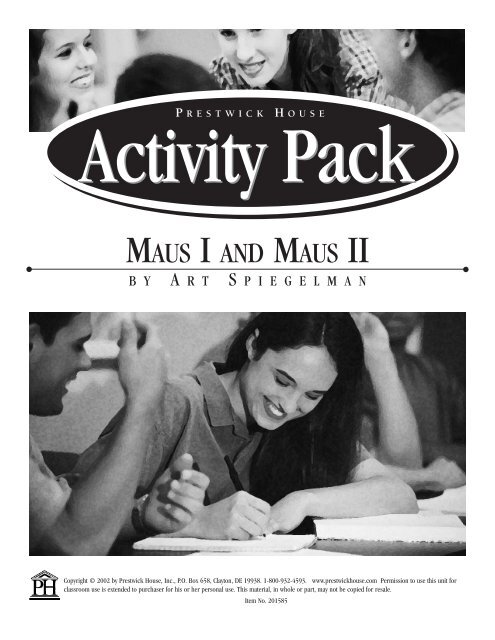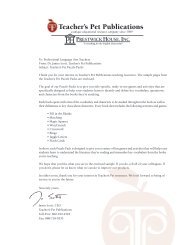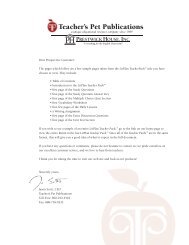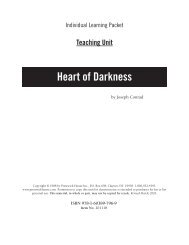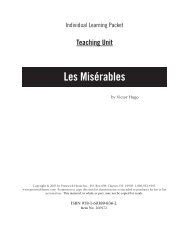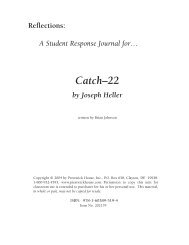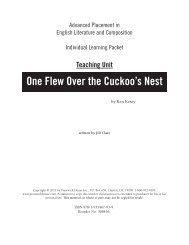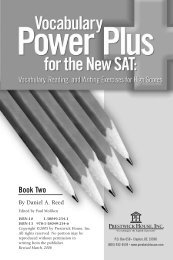Maus II: Pre-Reading - Prestwick House
Maus II: Pre-Reading - Prestwick House
Maus II: Pre-Reading - Prestwick House
Create successful ePaper yourself
Turn your PDF publications into a flip-book with our unique Google optimized e-Paper software.
P r e s t w i c k Ho u s e<br />
Activity Pack<br />
<strong>Maus</strong> I and <strong>Maus</strong> <strong>II</strong><br />
b y a r t s p I e g e l M a n<br />
Copyright © 2002 by <strong>Pre</strong>stwick <strong>House</strong>, Inc., P.O. Box 658, Clayton, DE 19938. 1-800-932-4593. www.prestwickhouse.com Permission to use this unit for<br />
classroom use is extended to purchaser for his or her personal use. This material, in whole or part, may not be copied for resale.<br />
Item No. 201585
Student’s Page <strong>Maus</strong> I & <strong>Maus</strong> <strong>II</strong><br />
Name: ________________________________ Date:_________________<br />
<strong>Maus</strong> I: <strong>Pre</strong>-<strong>Reading</strong><br />
Emotion<br />
Objective: Understanding how facial expressions convey emotion<br />
Activity<br />
Art Spiegelman, the author of <strong>Maus</strong>, gives the following explanation about his use of comics to tell a story<br />
about serious subjects:<br />
I prefer the word “commix,” to mix together, because to talk about comics is to talk about mixing together<br />
words and pictures to tell a story...The strength of commix lies in its synthetic ability to approximate a “mental<br />
language” that is closer to actual human thought than either words or pictures alone.<br />
One way Spiegelman helps the reader understand the thoughts and feelings of the characters in <strong>Maus</strong> is<br />
by drawing different facial expressions, which convey emotions. For instance, a wide-open mouth is often<br />
used to express shock, outrage, or intense pain.<br />
Make a collage of pictures or drawings of human faces that show an emotion. You may include different<br />
emotions or several that express the same emotion.<br />
S - 5 Reproducible Student Worksheet
Student’s Page <strong>Maus</strong> I & <strong>Maus</strong> <strong>II</strong><br />
Name: ________________________________ Date:_________________<br />
<strong>Maus</strong> I: Chapter 1<br />
<strong>Reading</strong> Check<br />
Objective: Understanding character values and motivations<br />
Activity<br />
As Vladek relates the story of how he met his wife Anna, he reveals things that are important to him. What<br />
are they? Support your responses with quotations from what Vladek says. Use the Chapter 1 <strong>Reading</strong> Check<br />
Response Sheet on the following page.<br />
S - 19 Reproducible Student Worksheet
Student’s Page <strong>Maus</strong> I & <strong>Maus</strong> <strong>II</strong><br />
Name: ________________________________ Date:_________________<br />
<strong>Maus</strong> I: Chapter 2<br />
Symbolism<br />
Objective: Responding to the use of symbols and signs<br />
Activity<br />
Vladek explains that on the train ride to the sanitarium, he sees the swastika for the first time.<br />
• Examine the visual representations of Nazi abuse of Jews, both in the book and from any other<br />
sources you can find.<br />
• Create a poster to represent abusive treatment of any minority group.<br />
S - 41 Reproducible Student Worksheet
Student’s Page <strong>Maus</strong> I & <strong>Maus</strong> <strong>II</strong><br />
Name: ________________________________ Date:_________________<br />
Objective: <strong>Reading</strong> with attention to detail<br />
Activity<br />
<strong>Maus</strong> I: Chapter 4<br />
<strong>Reading</strong> for Details<br />
Often, when people consider the Holocaust, they ask how could the Jewish people allow themselves to be<br />
victimized; why didn’t they fight back? Although there are records of several rebellions and attempts to<br />
stop the killings, most Jews were not able to protect themselves. It is difficult, but try to imagine yourself<br />
as a Jewish person during this time in history as you engage in the following activity. Perhaps you will gain<br />
a better understanding of why so many of the Jewish people could not protect themselves.<br />
Working in small groups, select an identity from the list that follows.<br />
• Imagine you actually are the person you have selected. What would you do if you were this person<br />
and lived in Poland between 1940-1943.<br />
• Use the next sheet to formulate a plan of action. <strong>Pre</strong>pare an explanation for each part of your plan.<br />
Why will you take each action in your plan?<br />
• List the things that you will guard against. Include at least 5 details about what Jewish people<br />
experience that you have learned from <strong>Maus</strong>.<br />
• Describe what you think will probably happen to you and the reasons you think this will happen.<br />
Each group should present its plan, including the cautions to be taken and the expected outcome.<br />
Different Identities from Which to Choose:<br />
• a 70-year-old Jewish woman who lives alone<br />
• a young, strong single man who lives with his Jewish parents<br />
• a strong single woman who lives with her Jewish parents<br />
• an elderly Jewish man who lives with his wife<br />
• a young, Jewish married couple with no children<br />
• an elderly Jewish man who lives alone<br />
• a middle-aged Jewish widow with five children, ages 6-15<br />
• a wealthy Jewish couple in their 50’s with married children<br />
• a 50-year-old Jewish man with a sick wife and one teenage son<br />
S - 51 Reproducible Student Worksheet
Student’s Page <strong>Maus</strong> I & <strong>Maus</strong> <strong>II</strong><br />
Name: ________________________________ Date:_________________<br />
<strong>Maus</strong> I: Chapters 5 – 6<br />
Point of View<br />
Objective: Considering parts of the text from a different point of view<br />
Activity<br />
While Anja and Vladek are hiding, moving from one bunker to another, Anja always wrote in her diaries.<br />
In the present, though, Vladek has already told Artie that these notebooks have not survived the war.<br />
Each small group should select a different section of text to work with from the list that follows. As a<br />
group, write what you think Anja would have written in her notebooks. Use the following sections of text<br />
for information about what she is experiencing. You will have to expand on her thoughts and feelings<br />
from the text. Each group should share its diary entries with the class.<br />
S - 61 Reproducible Student Worksheet
Student’s Page <strong>Maus</strong> I & <strong>Maus</strong> <strong>II</strong><br />
Name: ________________________________ Date:_________________<br />
<strong>Maus</strong> <strong>II</strong>: <strong>Pre</strong>-<strong>Reading</strong><br />
Inference<br />
Objective: Understanding the subtitle, dedication and introduction<br />
Activity<br />
Compare the subtitle of this book, “And Here My Troubles Began,” to the title of <strong>Maus</strong>, “My Father Bleeds<br />
History.”<br />
What differences in these parts do you notice? Compare and contrast everything that comes before the<br />
actual cartooning begins. What do you think C is trying to convey by each of the three aspects.<br />
______________________________________________________________________________________<br />
______________________________________________________________________________________<br />
______________________________________________________________________________________<br />
______________________________________________________________________________________<br />
______________________________________________________________________________________<br />
______________________________________________________________________________________<br />
______________________________________________________________________________________<br />
______________________________________________________________________________________<br />
______________________________________________________________________________________<br />
______________________________________________________________________________________<br />
S - 77 Reproducible Student Worksheet
Student’s Page <strong>Maus</strong> I & <strong>Maus</strong> <strong>II</strong><br />
Name: ________________________________ Date:_________________<br />
<strong>Maus</strong> <strong>II</strong>: Chapters 3 – 5<br />
Irony<br />
Objective:` Understanding how irony creates meaning in a literary text<br />
Activity<br />
Discuss the contradictions in the example you choose. Plan a way to dramatize the contrasts and contradictions<br />
you find in the text. Write out the script, dialogue, and speeches you will use. Be sure you make the discrepancies<br />
apparent. Write a short explanation of the thematic idea this irony suggests. All groups should present their<br />
dramatizations to the class.<br />
Examples of Irony:<br />
• Pgs. 81 – 88: the irony of the German activity of bringing all prisoners to Germany<br />
• Pg 82: Vladek’s ironic comment about how humans die similarly to dogs, especially in light of<br />
Spiegelman’s use of animals for all different races and how the Nazis used dogs<br />
• Pgs. 98 – 100: the irony of racism<br />
• Pg. 88: ironically, the Red Cross can only provide a small portion of food and nothing else<br />
• Pgs. 105 – 110: the irony of the end of the war for the prisoners<br />
• Pg. 114: the irony of how the Americans treat Vladek<br />
• Pg. 117: Vladek’s final comment<br />
• Pgs. 129 – 136: the contrast of Vladek in the past and in the present<br />
• Pg. 131, 133 – 136: the irony of Anja’s suicide after her miraculous survival.<br />
• Pg. 132: the irony of: “For THIS he survived”<br />
S - 91 Reproducible Student Worksheet
Student’s Page <strong>Maus</strong> I & <strong>Maus</strong> <strong>II</strong><br />
Name: ________________________________ Date:_________________<br />
<strong>Maus</strong> <strong>II</strong>: Chapter 3<br />
Plot and Irony<br />
Objectives: Creating an alternate plot by extracting story information, and inferring the thoughts and<br />
feelings of a character<br />
Writing a news story relating the Holocaust to present day racism<br />
Activity<br />
Vladek and his friends attempt to hide before they leave Auschwitz. Write the details of an escape plan,<br />
including a diagram of the immediate area and the route that will be taken.<br />
You are a journalist for The New York Times, and your boss has instructed you to cover the story of the<br />
prisoners’ return to Germany. Starting with the march from Auschwitz to Gross-Rosen, write an article<br />
describing the events leading up to their arrival in Dachau. Be sure to title your article and, if you like,<br />
include any comments made by witnesses.<br />
Art is shocked to discover that his father, after surviving the Holocaust, is a racist. Draw an editorial<br />
cartoon addressing the irony of a prejudiced Holocaust survivor.<br />
S - 95 Reproducible Student Worksheet
Student’s Page <strong>Maus</strong> I & <strong>Maus</strong> <strong>II</strong><br />
Name: ________________________________ Date:_________________<br />
<strong>Maus</strong> <strong>II</strong>: Chapter 5<br />
Critical Thinking and Writing<br />
Objectives: Inferring the thoughts and feelings of a character<br />
Improving critical thinking and writing skills<br />
Writing an introduction<br />
Activity<br />
When the war ends, Vladek begins working his way to Sosnowiec, Poland, to search for Anja. As Vladek,<br />
write a letter to Anja explaining your current situation and what you are doing to find her.<br />
You are chosen to conduct a television interview of Vladek. Compose ten questions to ask him in the<br />
interview about his experiences during the Holocaust. Ask questions that are informative to your viewing<br />
audience. Pair up with another student. Each person will take a turn being the interviewer and being<br />
Vladek. As the interviewer, record the answers you receive and use any follow-up questions that you see<br />
fit in order to get a more thorough interview.<br />
Write an introduction of one or two pages to <strong>Maus</strong> <strong>II</strong> analyzing its key elements. Your essay may include a plot<br />
summary and information about the author, Art Spiegelman, that pertains to the development of his story.<br />
Include major elements of the book such as character, setting, use of symbol, and historical and social contexts.<br />
In developing your essay, include specifics from the book to support and illustrate your generalizations.<br />
On Page 134, is an actual picture of Vladek in his concentration camp uniform. He looks fairly healthy,<br />
so this must have been taken early on or after his freedom in a posed picture. Compose a short paragraph<br />
about his thoughts. Write them in his own particular style of speaking, if you can.<br />
S - 101 Reproducible Student Worksheet


